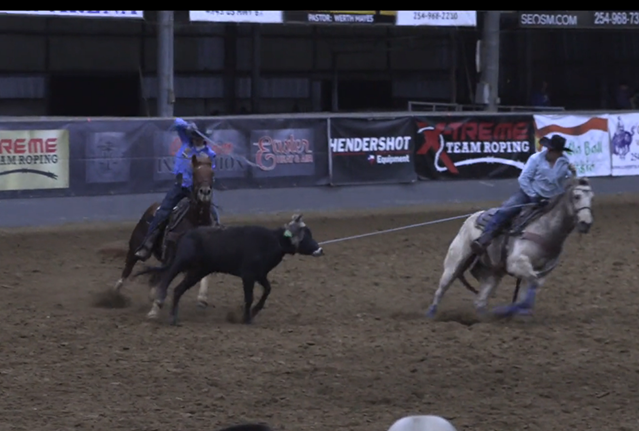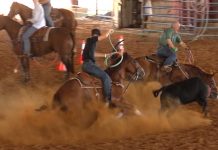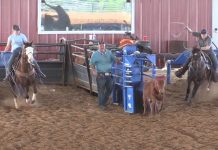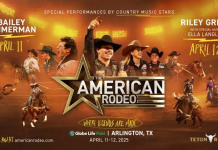Breaking it Down by Speed Williams – May 2024
This month we’re going to tackle a tricky topic… setting up a good handle. There are many ways to handle steers and many different kinds of steers. Old steers, fresh steers, steers that go right, steers that go left. The math can get very complicated.
For now, we’ll talk about good medium plus steers that run straight down the arena. It’s important that the speed of the head horse match the speed of the steer. If the head horse is going too fast, or faster than the steer when you initiate the corner, it will cause the steer to go down the arena too much and drift to the right, away from the heeler.
Now, if the head horse dies off and stops and you take hold of the steer from behind while slowing too fast, that will cause you to kill him off in the corner. This is detrimental because the heeler is coming in and could run over top of him. Both variables occur when the head horse is not going the same speed as the steer when the corner is initiated.
This really separates high and low numbered headers. The goal should be to clean up the steer and make him easy to heel as quickly as possible. This is accomplished by using your left hand, left foot, and right foot correctly in the corner. It is one of the most complicated moves in heading. The math changes on the fly and you need to be able to react to the steer and get your horse in the correct angle.
Advanced headers will slide rope to compensate for what their horse doesn’t do correctly. When I first started heading and came west, I was scolded whenever I would slide too much rope. Heelers don’t want you sliding rope because they don’t know what the steer will do. I worked very hard at handling steers, and I slid rope a lot to compensate for my horse. I would have rubber all over my pant leg. When done incorrectly, you can make your heeler look really bad. But when done right, you can hop the steer off smooth and easy and make your heeler look good.
It’s unnecessary to slide rope if you’re riding an extremely broke horse that you can control. Done correctly it can be helpful to compensate when the head horse drops back too hard, hits the corner too hard, or goes left too hard. If you’re a young header, don’t take offense to heelers telling you not to slide rope. What they mean is don’t slide too much or let it get away from you.
Learning the art of sliding rope to soften the corner can really help keep a steer on his feet and make him easier to heel. It can be tricky because if the header slides too much rope, it puts the heeler too close and in a bad position. But when you’re trying to be three and four seconds, it’s vital to learn. Not nearly as important in the #7 and #8 roping, but the higher the ropings go, the more crucial it becomes to handle steers fast.
One of the most common questions I get from low numbered ropers is, “what do we do on a steer that runs up the rope?” My dad was a trainer, and we roped a lot of slow steers, head duckers, and steers that followed and ran up the rope. When roping a steer that is experienced running up the rope, it’s common that for every move you make like speeding up and trying to get ahead, the steer will have a counter move.
It really comes down to the heeler has to hustle to try and get in position to rope the steer. The header needs to keep pressure on his head and keep the head rope tight to have some control over the cow. Every steer is different, and I’ve had some that once they were roped, it was hard to get the head rope tight whether you went fast or turned back. Sometimes the header doesn’t have many options. But when a heeler sees the steer running up the rope they need to hustle and try and get in position because most of the time it’s only going to get worse.
The number one factor in handling steers is having the head horse at the same speed as the steer. Then it comes down to how broke the head horse is. Does he side pass, flex, and are you able to control your horse with your feet and left hand. If you can’t side pass with your right leg, setting up the corner becomes rather difficult.
My heading students do a set of drills where they have to weave through poles or barrels and learn to use their feet to control their horse while swinging their rope. I’ve had some #6 and #7 headers that struggled with that drill, but it makes a world of difference once they learned how to do it.
Throughout my career I’ve watched a lot of guys that do a great job of getting it on one fast, but get excited and let their horse duck, jerking the steer ten feet in the corner, instead of picking up their horse and giving their heeler an easy throw. I’ve seen guys who could score and rope outstanding but make their heelers work for it every time.
What’s new: Hali’s foot/knee is getting better and she’s able to practice more. She recently made an outstanding run at Huntsville. Usually after a run like that, she’s down for several days and can’t rope. Though she still experiences a lot of pain, now she’s able to rope four or five days in a row. Gabe has been working on his heading. He tends to get excited and go left when he ropes fast, and we’ve been working on his handles. I’m excited about teaching my son to head. We have a long way to go but I’m anxious to see how far we get in the next few months.




